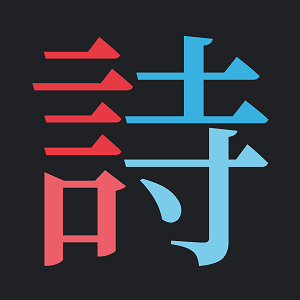詩
부수: 言
획수: 13획
詩 has the meanings ‘poetry’, and ‘poem’.

詩 = 言 + 寺
X = semantic + phonetic
• 言 depicts speech organs and represents the meaning ‘speech’.
• 寺 is an abbreviation of 持 (meaning ‘to grasp’), but is used for its sound.
Evolution:
詩 = ’expression through spoken language’ ➔ ’poetry’
言 =  + 口
+ 口
•  is a distortion of the original form (see below).
is a distortion of the original form (see below).
• 口 depicts a mouth.
言 was originally 舌 which depicts a tongue. From this comes the meaning ‘speech’.
In 詩 it represents ‘expression through spoken language’.
寺 = 士 + 寸
• 士 depicts an axe-like tool and has the meaning ‘foot soldier’ (soldiers are of low noble rank).
• 寸 depicts ‘a hand’ with a mark below the wrist where the pulse is taken. This represents actions done with the hand. From this comes the meaning ‘to grasp’.
Some scholars suggest 寺 is associated with ‘moving forward’ and thus ‘moving thoughts forward’. In this way, 詩 gets its original meaning of ‘moving thoughts forward through language’.
Mnemonic
Understand that 寺 is comprised of 士 (axe-like tool) and 寸 (a hand with a mark below the wrist where the pulse is taken).
Pretend that 士 is a quill pen. Imagine writing a poem 詩 with a quill in your right hand. Your wrist has a throbbing pulse 寸 which is a manifestation of your inner feelings. This pulse guides the movements of the pen as you move your thoughts forward into beautiful words 言.
Vocab
| 詩 | 시 | poetry, lines of verse |
| 詩人 | 시인 | poet |
| 詩集 | 시집 | poetic works; collection of poems |
| 詩想 | 시상 | poetic concept; poetic ideas |
| 詩形 | 시형 | poetic form; verse |
| 童詩 | 동시 | children’s poetry |
| 名詩 | 명시 | great poem |
| 敍事詩 | 서사시 | epic poem |
| 抒情詩 | 서정시 | lyric poetry |
Other resources
Image searches
Google
Bing
Yahoo Japan
Baidu (click 图片)
Sogou
Pinterest
Flickr
CJKV
CJKV Dict
Wikitionary
Unihan Database
Korean
Chinese
Written Chinese
Arch Chinese
ZDic
CC-Canto
Chinese Text Project
The Chinese University of Hong Kong (etymology)
Chinese Boost
Japanese
Takoboto
Jisho
JLearn.net
Sakura
The Kanji Map
Sentence Search
Immersion Kit
Vietnamese
Bibliography
Affiliate links help support uK.
— Grant, B.K. (1982). A Guide To Korean Characters: Reading and Writing Hangul and Hanja, [s.v. 1307]. Seoul: Hollym.
— Henshall, K.G. (1998). A Guide to Remembering Japanese Characters, [s.v. 291]. Singapore: Tuttle Publishing.
— Outlier Dictionary of Chinese Characters, [s.v. 詩, 言, 口, 寺, 士, 寸].
— Seely, C., Henshall, K.G., & Fan, J. (2016). The Complete Guide to Japanese Kanji: Remembering and Understanding the 2,136 Standard Japanese Characters, [s.v. 307]. Singapore: Tuttle Publishing.